Parameter Optimization of Hole-Slot-Type Magnetron for Controlling Resonant Frequency of Linear Accelerator 6 MeV by Reverse Engineering Technique
Abstract
:1. Introduction
2. Research Methodology
2.1. Magnetron Structure Analysis
2.1.1. Geometric Dimensioning and Tolerancing
2.1.2. Interaction between Electrons and Fields
2.1.3. Hull Cut-off and Hartree Conditions
2.2. Theoretical Magnetron Analysis
2.2.1. The Analysis of Resonant Frequency by Equivalent Circuit Method
2.2.2. The Analysis of Resonant Frequency by PIC Simulation Method
2.3. Linear Acerelerator for the Sterilization System
2.3.1. Fuzzy Logic Control for the LINAC Sterilization
2.3.2. Implementation of the Fuzzy Controller
3. Experimental Results
3.1. The Results of the Operating Point of the Twelve-Hole-Slot-Type Magnetron
3.2. The Results of the Resonant Frequency by Using the Equivalent Parallel Circuit
3.3. The Results of the Resonant Frequency by Using PIC Simulation Method
3.4. Results of Experimental Setup
4. Conclusions
- The estimation of the operating point of the magnetron in dominant mode was conducted, generating a resonant frequency of 2.9982 GHz, after measuring the geometry of the inner structure of the magnetron using a CMM with a resolution of 0.5 µm. The results of the normal cavity radius yielded a tolerance value of 3.195 ± 0.00025 mm. The results of the boundary condition to operate the magnetron were an anode voltage range between 41.0 and 74.2 kV and a permanent magnetic field of around 0.152 tesla.
- The estimation of the resonant frequency was done by using the equivalent parallel circuit of the magnetron in operation modes 1 to 11. This resulted in a resonant frequency in pi-mode at the desired anode voltage of 45 kV with TSLOT position of 3.97 mm. The measured cavity radius of 3.195 ± 0.00025 mm has a relative error of 0.02% with reference to the target frequency load of 2.9982 GHz.
- The resonant frequency can be estimated by using PIC simulation in the CST Particle Studio program. The results of the resonant frequency in pi-mode with TSLOT position as 3.97 mm and a cavity radius of 3.195 ± 0.00025 mm yield a relative error of 0.03% with reference to the target frequency of the accelerator tube.
- The design and the manufacturing of the prototype of the magnetron with tolerance are required for PIC simulation. Based on the standard measured cavity radius of 3.195 ± 0.00025 mm, a cavity radius in the range of –8 µm to +20 µm and TSLOT tuning of 3.22 to 8.22 mm are sufficient to tune the resonant frequency of the magnetron equivalent to a LINAC frequency of 2.9982 GHz. Thus, the manufacturing of the prototype of the magnetron at a resonant frequency of 2.9982 GHz is required by a CNC machine which has a tolerance of less than ±14 µm, approximately. The advantages of a reverse engineering technique are studied to reach the structural dimensions and solve the operating point of the magnetron in dominant mode.
- The control system for magnetron is based on the fuzzy logic of the Takagi–Sugeno method agrees well with the LINAC’s frequency with an anode voltage supply in pi-mode of 45-kV and magnetic field of permanent magnet of 0.15 T.
Author Contributions
Funding
Institutional Review Board Statement
Informed Consent Statement
Data Availability Statement
Acknowledgments
Conflicts of Interest
References
- Sattorov, M.A.; Bera, A.; Sharma, A.; Kang, W.-J.; Kwon, O.-J.; Jung, S.-S.; Kim, D.-H.; Lee, K.W.; Won, J.-H.; Kook, C.H.; et al. Thermal Analysis of a Strapped Magnetron. IEEE Trans. Electron Devices 2011, 58, 2784–2788. [Google Scholar] [CrossRef]
- Joshi, M.K.; Vyas, S.K.; Tiwari, T.; Bhattacharjee, R. Particle-in-Cell Simulation and Analysis of 28-Vane Megawatt-Class Pulsed Power Coaxial Magnetron in X-Band. IEEE Trans. Plasma Sci. 2020, 48, 1886–1893. [Google Scholar] [CrossRef]
- Isenlik, T.; Yegin, K. Tutorial on the Design of Hole-Slot-Type Cavity Magnetron Using CST Particle Studio. IEEE Trans. Plasma Sci. 2013, 41, 296–304. [Google Scholar] [CrossRef]
- Lee, J.-H.; Kim, G.-J.; Kim, S.; Lee, Y.-S.; Kim, I.S.; Kim, J.-I. Investigation of X-Band Coaxial Magnetron using Three-dimensional Particle-In-Cell Simulation. In Proceedings of the 2019 International Vacuum Electronics Conference (IVEC), Busan, Korea, 28 April–1 May 2019; pp. 1–2. [Google Scholar] [CrossRef]
- Khatoon, S.; Yadav, R.P.; Jain, A. Design and Simulation of 8-cavity hole-slot type magnetron in CST. In Proceedings of the 2018 2nd International Conference Electronics Materials Engineering & Nano-Technology (IEMENTech), Kolkata, India, 4–5 May 2018; pp. 1–5. [Google Scholar] [CrossRef]
- Joshi, M.K.; Vyas, S.K.; Tiwari, T.; Bhattacharjee, R. A New Approach for High-Power Coaxial Magnetron Using Stacked Anode Resonators. IEEE Trans. Electron Devices 2020, 67, 1808–1813. [Google Scholar] [CrossRef]
- Dipendra, J.; Mineo, M.M. Magnetron Development at E2V. In Proceedings of the ARMMS RF & Microwave Society Conference 2017, Chelmsford, UK, 3–4 April 2017; pp. 1–9. [Google Scholar]
- Yue, S.; Zhang, Z.; Gao, D. Equivalent Circuit Method of Resonant System of Magnetron with Sector and Slot Resonant Cavities. IEEE Trans. Plasma Sci. 2014, 42, 3968–3974. [Google Scholar] [CrossRef]
- Isa, A.; Dursun, A.; Demirci, E.; Korkmas, E.; Yegin, K. Simulation of an 18-Vane Magnetron in CST-PIC. In Proceedings of the 2011 XXXth URSI General Assembly and Scientific Symposium, Istanbul, Turkey, 13–20 August 2011. [Google Scholar]
- Han, J.-H.; Ryu, S.-K. Optimal Operating Conditions Based on Mode Competition for Maximum Efficiency of Double-Strapped Magnetron. IEEE Trans. Plasma Sci. 2019, 47, 3160–3167. [Google Scholar] [CrossRef]
- Yue, S.; Zhang, Z.-C.; Gao, D.-P. Theoretical investigation of resonant frequencies of unstrapped magnetron with arbitrary side resonators. Phys. Plasmas 2015, 22, 043112. [Google Scholar] [CrossRef]
- Yachum, N.; Russamee, N.; Srisertpol, J. Automatic frequency control of the magnetron system for medical linear accelerator using fuzzy logic control. In Proceedings of the XLVI International Summer School-Conference APM, Sankt Petersburg, Russia, 25–30 June 2018; pp. 275–285. [Google Scholar]
- Samuel, Y.L. Microwave Devices and Circuit, 3rd ed.; Prentice Hall: Upper Saddle River, NJ, USA, 1997; pp. 6–14. [Google Scholar]
- Tsimring, S.E. Electron Beams and Microwave Vacuum Electronics; John Wiley & Sons: Hoboken, NJ, USA, 2006. [Google Scholar]
- Jaindong, L. Investigation of Spatial Harmonic Magnetrons for High Power Millimetre and THz Wave Operations. Ph.D. Thesis, Queen Mary University of London, London, UK, November 2016. [Google Scholar]
- Ma, L. 3D Computer Modeling of Magnetrons. Ph.D. Thesis, Queen Mary University of London, London, UK, 2004. [Google Scholar]
- Fan, Y.-W.; Liu, J.; Zhong, H.-H.; Shu, T.; Li, Z.-Q. Theoretical investigation of the fundamental mode frequency of A6 magnetron. J. Appl. Phys. 2009, 105, 83310. [Google Scholar] [CrossRef]
- Sergiy, V.S.; Vavriv, D.M. Theory of the Spatial-Harmonic Magnetron an Equivalent Magnetron: An Equivalent Network Approach. IEEE Trans. Plasma Sci. 2002, 30, 984–991. [Google Scholar]
- Collins, G.B. Microwave Magnetron; McGrew-Hill: New York, NY, USA, 1948; pp. 49–54. [Google Scholar]
- Miller, R.B. Electronic Irradiation of Foods an Introduction to the Technology. In Food Engineering Series; Springer: Berlin/Heidelberg, Germany, 2005; pp. 137–150. ISBN 0-387-23784-4. [Google Scholar]
- Yue, S.; Zhang, Z.-C.; Gao, D.-P. Equivalent Circuit Method of π-Mode Frequency of Rising-Sun Magnetron. Terahertz Sci. Technol. 2014, 7, 193–197. [Google Scholar]
- CST Particle Studio. CST Studio suite. In Computer Simulation; CST Particle Studio: Darmstadt, Germany, 2010. [Google Scholar]
- Verma, R.K.; Maurya, S.; Singh, V.P. Particle-In-Cell (PIC) simulation of Spatial-Harmonic Magnetron (SHM). In Proceedings of the 2017 International Conference on Emerging Trends in Computing and Communication Technologies (ICETCCT), Dehradun, India, 17–18 November 2017; pp. 1–4. [Google Scholar]
- Qin, F.; Zhang, Y.; Xu, S.; Lei, L.-R.; Ju, B.-Q.; Wang, D. A Frequency-Agile Relativistic Magnetron with Axial Tuning. IEEE Electron Device Lett. 2020, 41, 781–783. [Google Scholar] [CrossRef]
- El Helou, A.; Raad, P.E.; Komarov, P. Temperature dependence of the thermoreflectance coefficient of gold by the use of a phase-locked single-point measurement approach. In Proceedings of the 2018 34th Thermal Measurement Modeling & Management Symposium (SEMI-THERM), San Jose, CA, USA, 19–23 March 2018; pp. 161–164. [Google Scholar] [CrossRef]
- Turner, J. Magnetron Automatic Frequency Control System. In EE498 Senior Design Project Report; University of Nevada: Las Vegas, NV, USA, 2012; pp. 1–8. [Google Scholar]
- Başçi, A.; Derdiyok, A. Implementation of an adaptive fuzzy compensator for coupled tank liquid level control system. Measurement 2016, 91, 12–18. [Google Scholar] [CrossRef]
- Petritoli, E.R.; Leccese, F.; Cagnetti, M. Takagi-Sugeno Discrete Fuzzy Modeling: An IoT Controlled ABS for UAV. In Proceedings of the 2019 II Workshop on Metrology for Industry 4.0 and IoT (MetroInd4.0&IoT), Naples, Italy, 4–6 June 2019; pp. 191–195. [Google Scholar]
- Raj, R.; Mohan, B.M. Modelling and analysis of a general Takagi-Sugeno fuzzy PI/PD controller with modified rule base. In Proceedings of the 2016 IEEE Student’s Technology Symposium (TechSym), Kharagpur, India, 30 September–2 October 2017; pp. 169–174. [Google Scholar] [CrossRef]
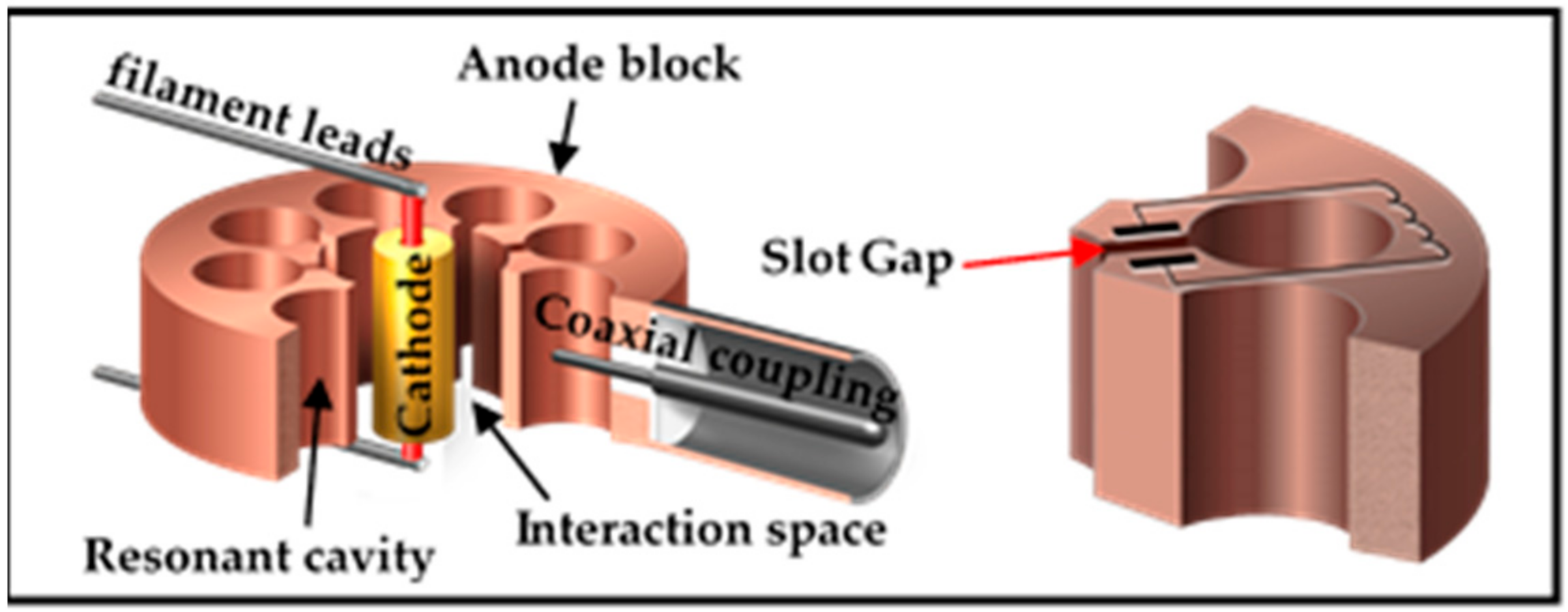
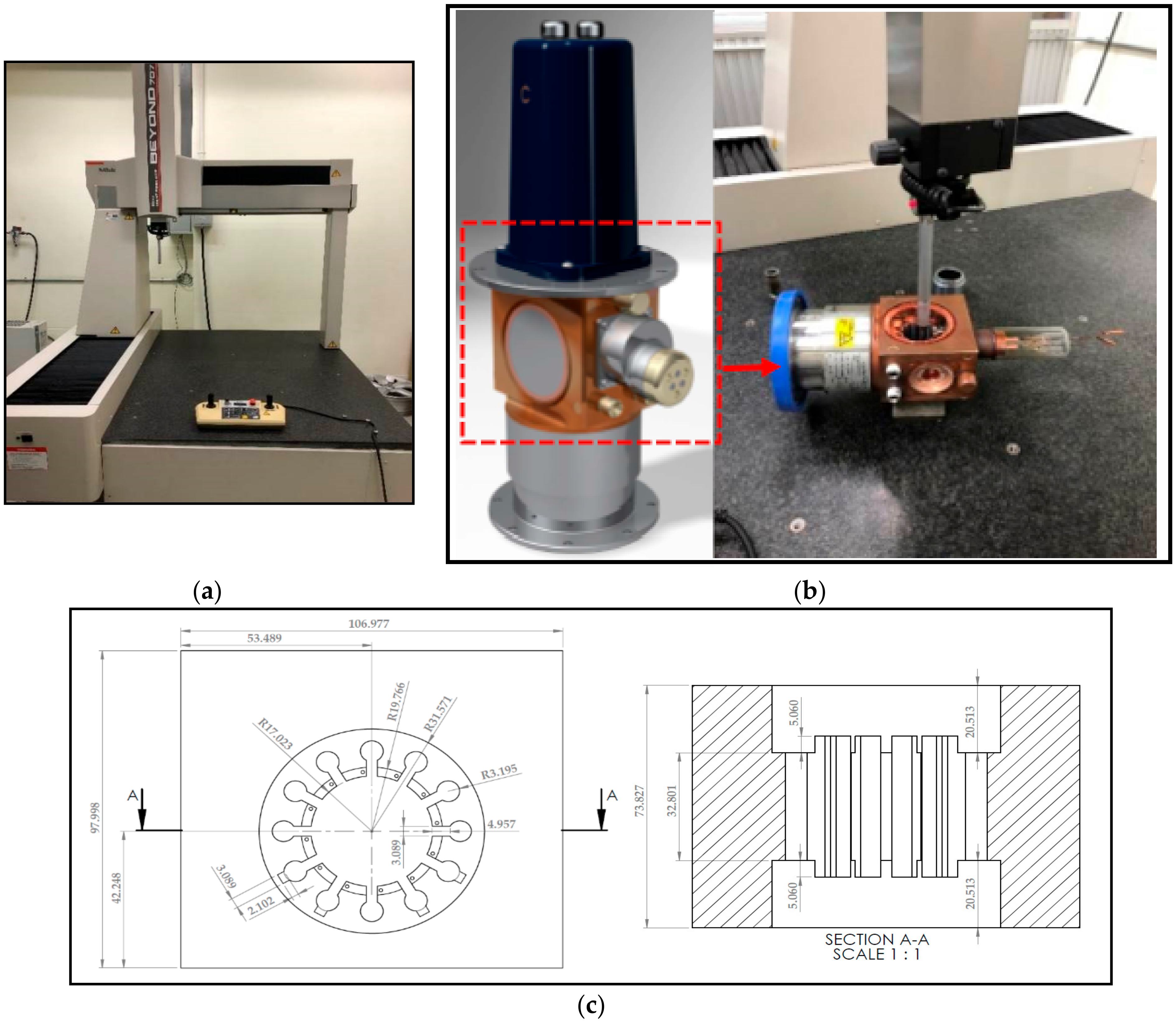
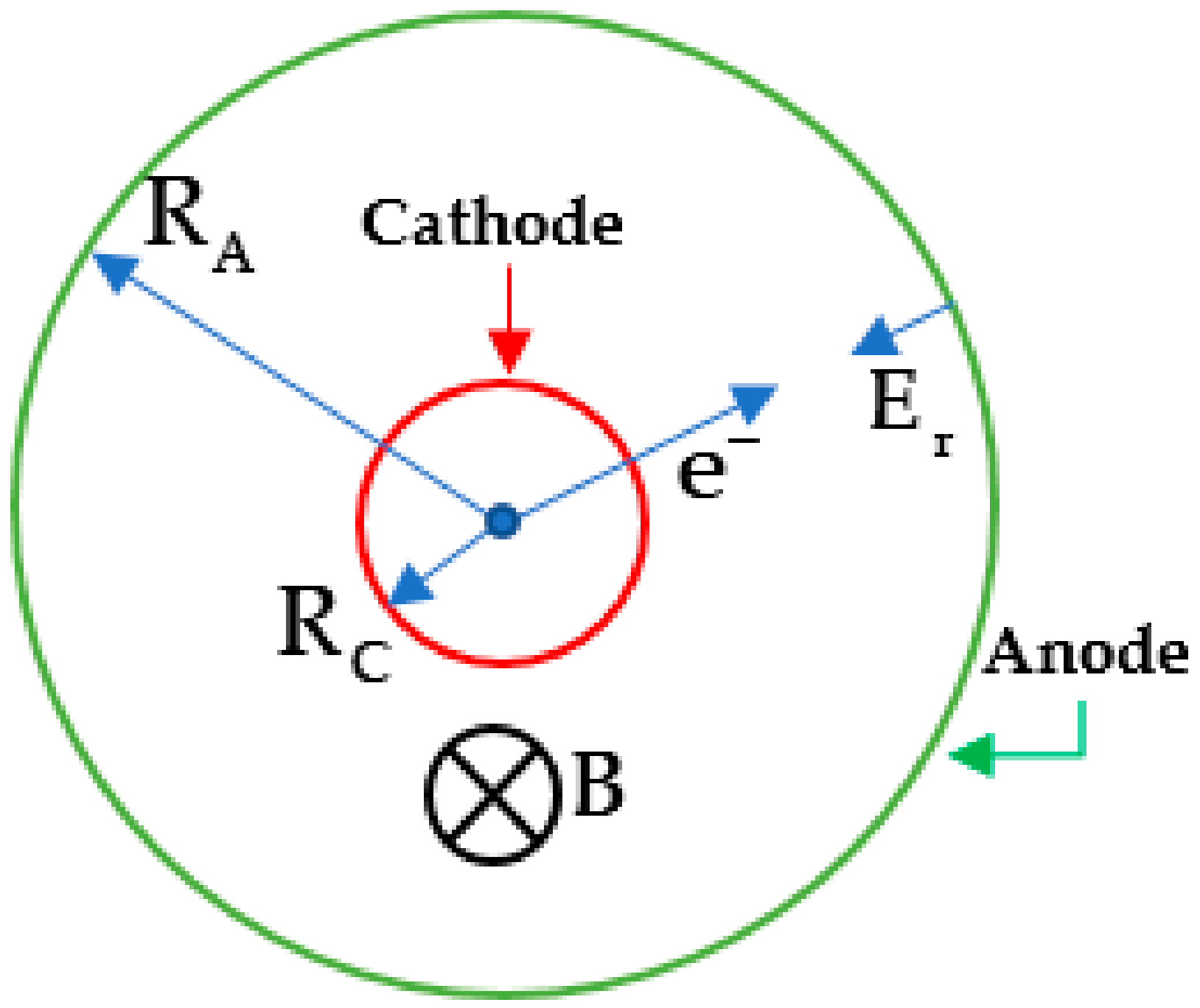
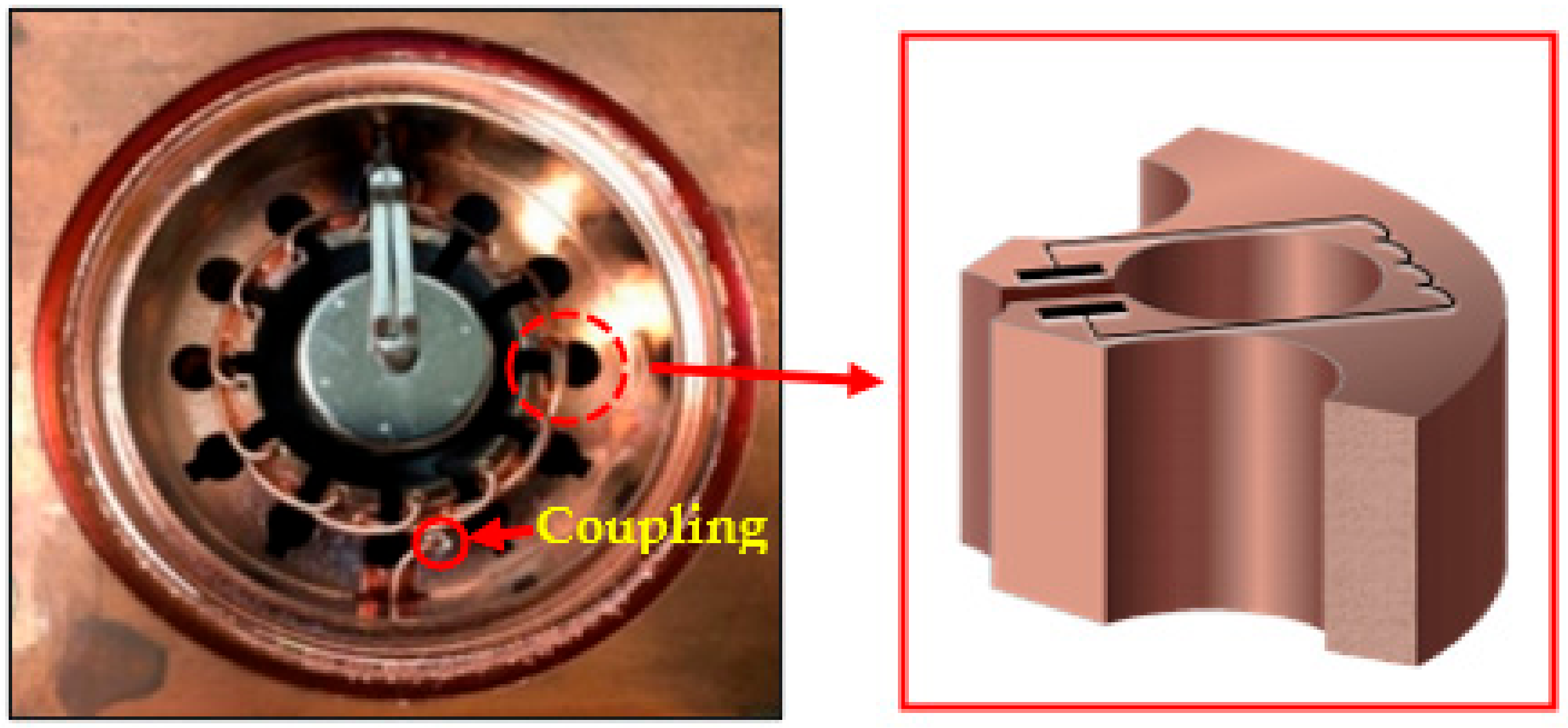





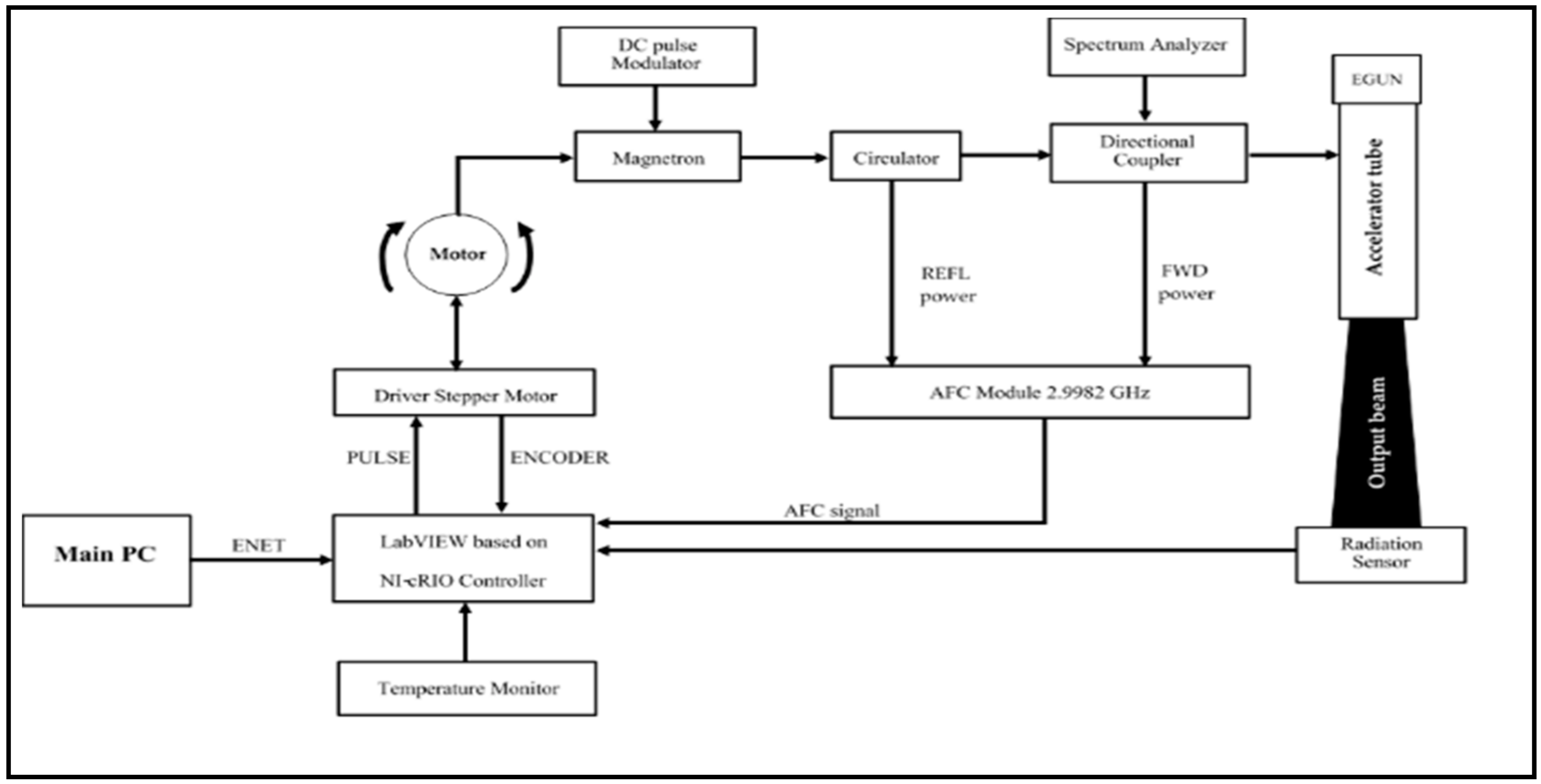



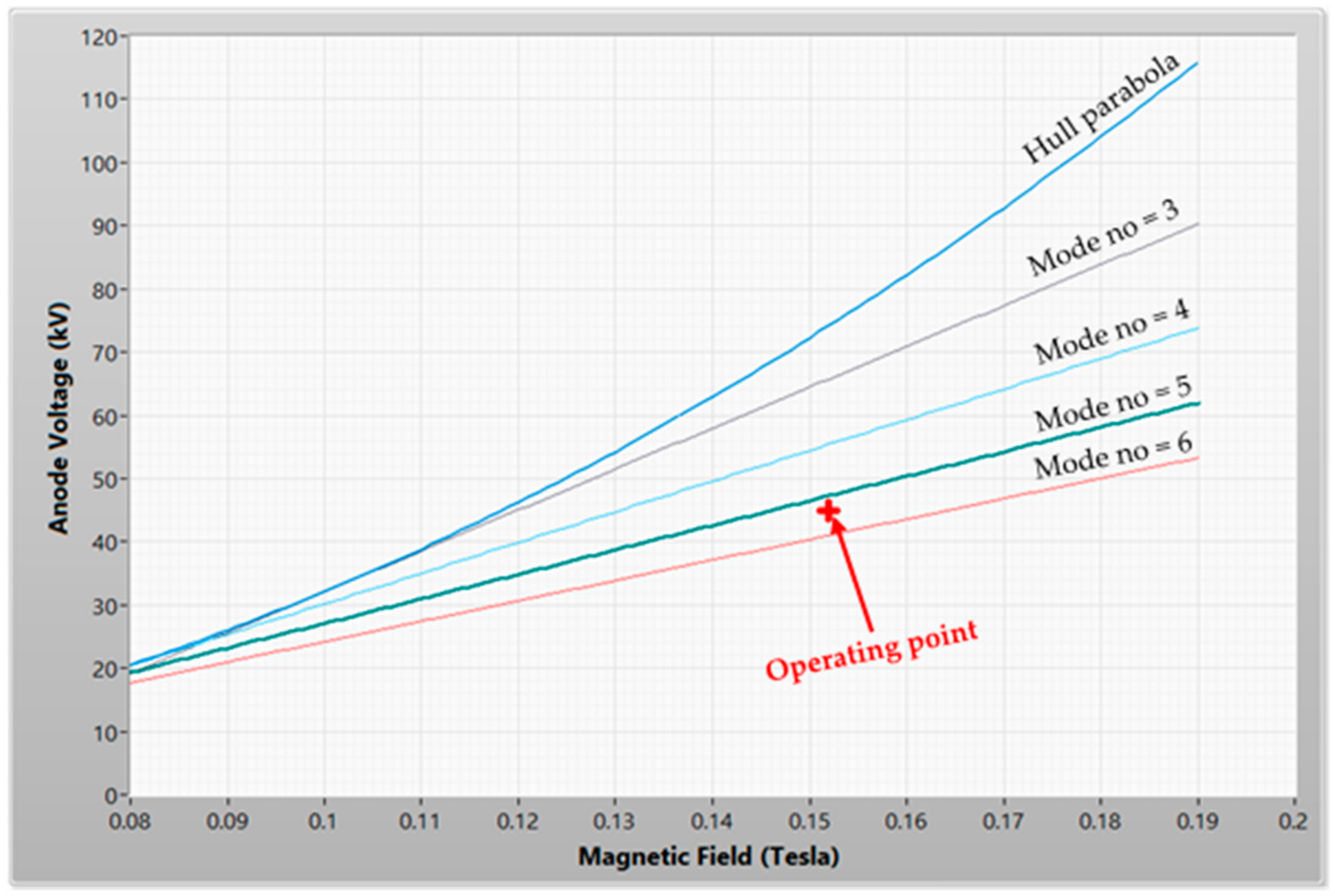
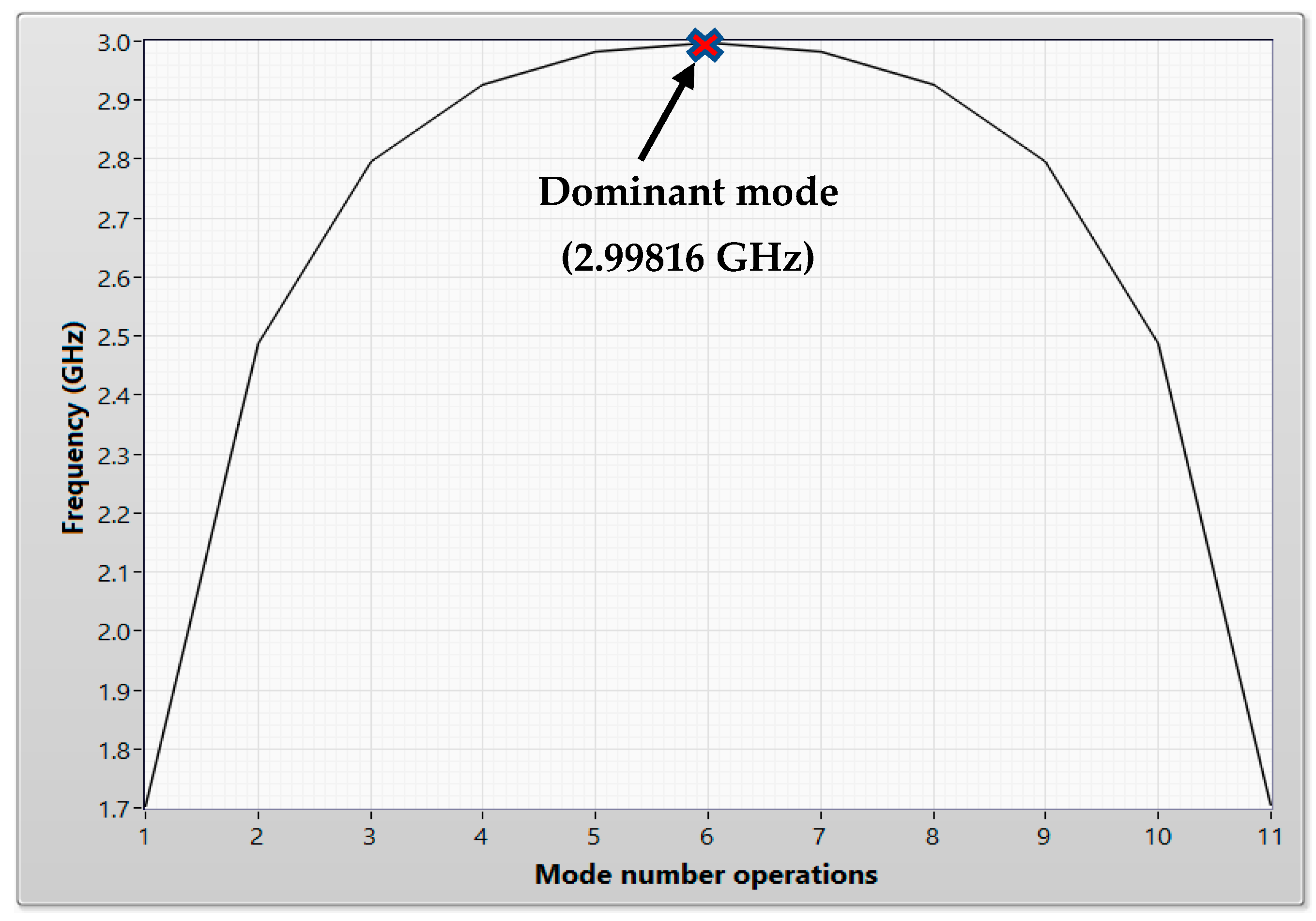





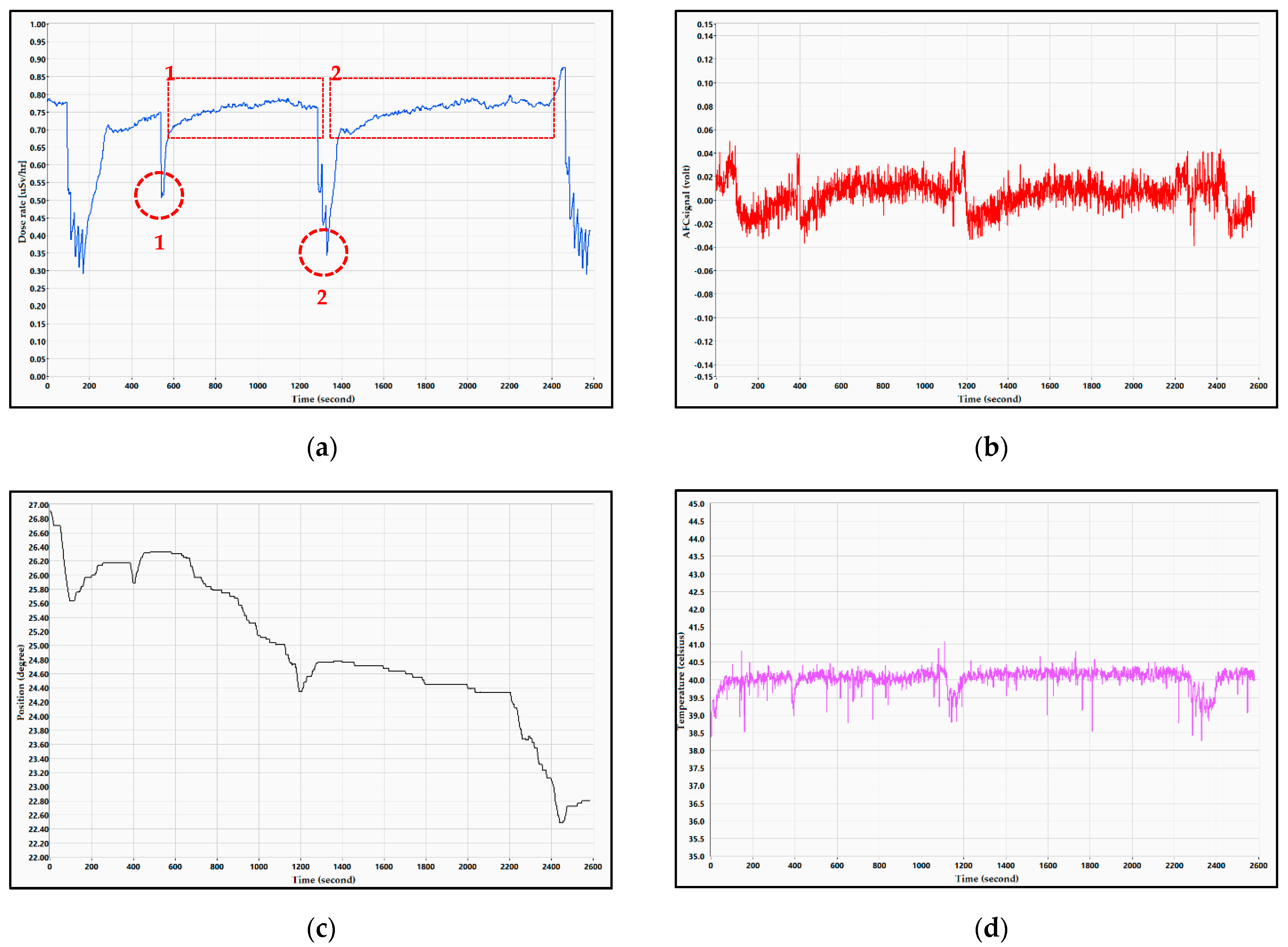
| Descriptions | Values |
|---|---|
| Number of resonant cavities | 12 |
| Cathode radius (RC) | 9.160 mm |
| Anode radius (RA) | 17.023 mm |
| Cavity radius (RV) | 3.195 mm |
| Voltage applied (VAPP) | 45,000 v |
| Permanent magnet (BAPP) | 0.152 t |
| Tuner slot distance (TSLOT) | 3.22–8.22 mm |
| No. | Input (Error) | Variable Input | Variable Output | Output (%) | Mean of Variable |
|---|---|---|---|---|---|
| 1 | ≤0 | VL | VL | 0 | Very Low |
| 2 | 25 | L | L | 15 | Low |
| 3 | 75 | M | M | 40 | Medium |
| 4 | 125 | H | H | 70 | High |
| 5 | ≥200 | VH | VH | 100 | Very High |
| Component | Data (Millimeters) |
|---|---|
| Anode radius (RA) | 17.023 ± 0.00025 |
| Cathode radius (RC) | 9.160 ± 0.00025 |
| Cavity radius (RV) | 3.195 ± 0.00025 |
| Height of anode (H) | 32.801 ± 0.00025 |
| Gap length (LM) | 4.957 ± 0.00025 |
| Component | Data (Millimeters) |
|---|---|
| Kinetic energy | 3 eV |
| Rise time | 1 ns |
| Duration time | 150 ns |
| Anode material | Copper annealed |
| Electrical conductivity | 5.8 × 107 S/m |
| Temperature coefficient | 0.00393 K−1 |
| Ambient temperatures | 20 °C |
| Tuner Slot Distance (mm) | The Frequency of the Cavity Radius (GHz) | ||||||||||
|---|---|---|---|---|---|---|---|---|---|---|---|
| R3.145 | R3.170 | R3.185 | R3.187 | R3.190 | R3.195 | R3.200 | R3.207 | R3.215 | R3.220 | R3.245 | |
| 2.22 | 3.0083 | 2.9983 | 2.9933 | 2.9900 | 2.9883 | 2.9867 | 2.9850 | 2.9833 | 2.9800 | 2.9783 | 2.9650 |
| 2.97 | 3.0150 | 3.0033 | 2.9983 | 2.9950 | 2.9950 | 2.9933 | 2.9917 | 2.9883 | 2.9867 | 2.9850 | 2.9700 |
| 3.22 | 3.0167 | 3.0050 | 3.0000 | 2.9967 | 2.9967 | 2.9950 | 2.9933 | 2.9900 | 2.9883 | 2.9867 | 2.9717 |
| 3.47 | 3.0167 | 3.0067 | 3.0017 | 2.9983 | 2.9967 | 2.9967 | 2.9950 | 2.9917 | 2.9900 | 2.9867 | 2.9733 |
| 3.72 | 3.0183 | 3.0083 | 3.0033 | 3.0000 | 2.9983 | 2.9967 | 2.9950 | 2.9933 | 2.9917 | 2.9883 | 2.9750 |
| 3.97 | 3.0200 | 3.0083 | 3.0033 | 3.0000 | 3.0000 | 2.9983 | 2.9967 | 2.9933 | 2.9917 | 2.9900 | 2.9767 |
| 4.22 | 3.0217 | 3.0117 | 3.0067 | 3.0033 | 3.0017 | 3.0000 | 2.9983 | 2.9967 | 2.9933 | 2.9917 | 2.9783 |
| 5.22 | 3.0233 | 3.0133 | 3.0083 | 3.0050 | 3.0050 | 3.0033 | 3.0017 | 2.9983 | 2.9967 | 2.9950 | 2.9800 |
| 6.22 | 3.0267 | 3.0167 | 3.0117 | 3.0083 | 3.0067 | 3.0050 | 3.0033 | 3.0017 | 2.9983 | 2.9967 | 2.9833 |
| 7.22 | 3.0267 | 3.0167 | 3.0117 | 3.0083 | 3.0067 | 3.0067 | 3.0033 | 3.0017 | 3.0000 | 2.9967 | 2.9833 |
| 8.22 | 3.0283 | 3.0167 | 3.0117 | 3.0100 | 3.0083 | 3.0067 | 3.0050 | 3.0017 | 3.0000 | 2.9983 | 2.9850 |
| 9.22 | 3.0283 | 3.0167 | 3.0117 | 3.0100 | 3.0083 | 3.0067 | 3.0050 | 3.0033 | 3.0000 | 2.9983 | 2.9850 |
| Tuner Slot Distance (mm) | The Frequency of the Cavity Radius (GHz) | |||||||||||
|---|---|---|---|---|---|---|---|---|---|---|---|---|
| R3.145 | R3.170 | R3.185 | R3.187 | R3.190 | R3.195 | R3.200 | R3.207 | R3.215 | R3.220 | R3.245 | ||
| 2.22 | 3.00855 | 2.99734 | 2.99068 | 2.98979 | 2.98847 | 2.98626 | 2.98406 | 2.98098 | 2.97748 | 2.97530 | 2.96446 | |
| 2.97 | 3.01558 | 3.00435 | 2.99767 | 2.99678 | 2.99545 | 2.99324 | 2.99103 | 2.98795 | 2.98444 | 2.98226 | 2.97139 | |
| 3.22 | 3.01733 | 3.00610 | 2.99942 | 2.99853 | 2.99720 | 2.99499 | 2.99278 | 2.98970 | 2.98619 | 2.98400 | 2.97313 | |
| 3.47 | 3.01798 | 3.00674 | 3.00006 | 2.99917 | 2.99784 | 2.99563 | 2.99342 | 2.99034 | 2.98682 | 2.98464 | 2.97376 | |
| 3.72 | 3.01925 | 3.00800 | 3.00132 | 3.00043 | 2.99910 | 2.99689 | 2.99468 | 2.99159 | 2.98808 | 2.98589 | 2.97502 | |
| 3.97 | 3.02138 | 3.01013 | 3.00344 | 3.00255 | 3.00122 | 2.99901 | 2.99680 | 2.99371 | 2.99020 | 2.98800 | 2.97712 | |
| 4.22 | 3.02388 | 3.01263 | 3.00593 | 3.00504 | 3.00371 | 3.00149 | 2.99928 | 2.99619 | 2.99268 | 2.99048 | 2.97959 | |
| 5.22 | 3.02609 | 3.01483 | 3.00813 | 3.00724 | 3.00590 | 3.00369 | 3.00147 | 2.99838 | 2.99486 | 2.99267 | 2.98177 | |
| 6.22 | 3.02755 | 3.01628 | 3.00958 | 3.00869 | 3.00735 | 3.00513 | 3.00292 | 2.99983 | 2.99631 | 2.99411 | 2.98321 | |
| 7.22 | 3.02821 | 3.01693 | 3.01023 | 3.00934 | 3.00801 | 3.00579 | 3.00357 | 3.00048 | 2.99696 | 2.99476 | 2.98386 | |
| 8.22 | 3.02844 | 3.01717 | 3.01047 | 3.00958 | 3.00824 | 3.00602 | 3.00381 | 3.00072 | 2.99719 | 2.99500 | 2.98409 | |
| 9.22 | 3.02886 | 3.01759 | 3.01088 | 3.00999 | 3.00866 | 3.00644 | 3.00422 | 3.00113 | 2.99761 | 2.99541 | 2.98451 | |
Publisher’s Note: MDPI stays neutral with regard to jurisdictional claims in published maps and institutional affiliations. |
© 2021 by the authors. Licensee MDPI, Basel, Switzerland. This article is an open access article distributed under the terms and conditions of the Creative Commons Attribution (CC BY) license (http://creativecommons.org/licenses/by/4.0/).
Share and Cite
Yachum, N.; Chunjarean, S.; Russamee, N.; Srisertpol, J. Parameter Optimization of Hole-Slot-Type Magnetron for Controlling Resonant Frequency of Linear Accelerator 6 MeV by Reverse Engineering Technique. Appl. Sci. 2021, 11, 2384. https://doi.org/10.3390/app11052384
Yachum N, Chunjarean S, Russamee N, Srisertpol J. Parameter Optimization of Hole-Slot-Type Magnetron for Controlling Resonant Frequency of Linear Accelerator 6 MeV by Reverse Engineering Technique. Applied Sciences. 2021; 11(5):2384. https://doi.org/10.3390/app11052384
Chicago/Turabian StyleYachum, Nattawat, Somjai Chunjarean, Nilaped Russamee, and Jiraphon Srisertpol. 2021. "Parameter Optimization of Hole-Slot-Type Magnetron for Controlling Resonant Frequency of Linear Accelerator 6 MeV by Reverse Engineering Technique" Applied Sciences 11, no. 5: 2384. https://doi.org/10.3390/app11052384
APA StyleYachum, N., Chunjarean, S., Russamee, N., & Srisertpol, J. (2021). Parameter Optimization of Hole-Slot-Type Magnetron for Controlling Resonant Frequency of Linear Accelerator 6 MeV by Reverse Engineering Technique. Applied Sciences, 11(5), 2384. https://doi.org/10.3390/app11052384








